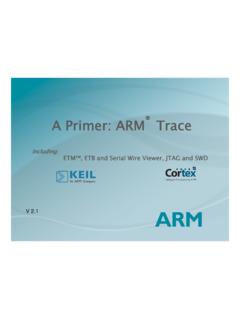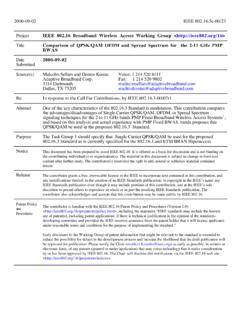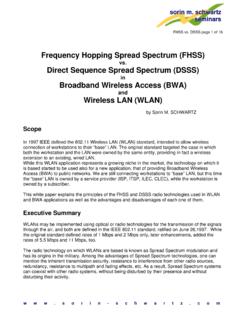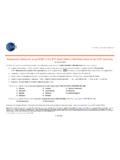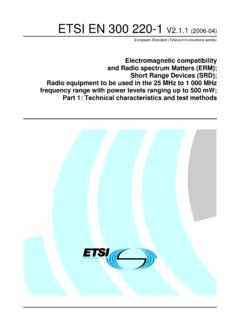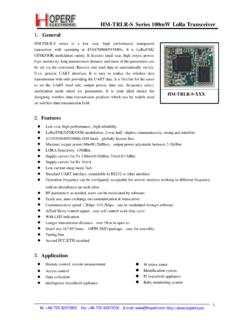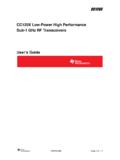Transcription of Protocolo IEEE 802.15 - SASE
1 Protocolo ieee Sergio Scaglia SASE 2012 - Agosto 2012 ieee standard Agenda Physical Layer for Wireless Overview MAC Layer for Wireless - Overview ieee Protocol Overview Hardware implementation specs 2 Sergio Scaglia FIUBA - NXP Semiconductors USA Physical Layer Communication Fundamentals over Wireless Channels Introduction Electromagnetic waves propagate in free space between a transmitter and a receiver (transceivers). Wireless channels are an unguided medium (in contrast with wired channels, where signals are propagated through the wire).
2 3 Sergio Scaglia FIUBA - NXP Semiconductors USA Physical Layer Communication Fundamentals over Wireless Channels frequency Allocation In RF-based systems, the carrier frequency determines the propagation characteristics (for example, obstacles penetration). 4 Sergio Scaglia FIUBA - NXP Semiconductors USA Physical Layer Communication Fundamentals over Wireless Channels frequency Band Since a single frequency (carrier) does not provide communication capacity, a frequency Band is assigned. When the carrier is modulated, multiple frequencies around the carrier conform a band.
3 The range of radio frequencies is subject to Regulation, to avoid unwanted interference between different users and systems. 5 Sergio Scaglia FIUBA - NXP Semiconductors USA Physical Layer Communication Fundamentals over Wireless Channels ISM license-free band ISM (Industrial, Scientific and Medical) band is unlicensed (although some restrictions apply). 6 Sergio Scaglia FIUBA - NXP Semiconductors USA Physical Layer Communication Fundamentals over Wireless Channels ISM license-free band - Considerations Interference: Since many systems share same bands, robustness is needed to avoid interference (more complicated modulation schemes need to be used).
4 Antenna Efficiency: Defined as the ratio of Radiated Power to the Total Input Power. Antennas efficiency decreases as the ratio of antenna dimension to wavelength decreases. Thus, more energy must be spent. 7 Sergio Scaglia FIUBA - NXP Semiconductors USA Physical Layer Communication Fundamentals over Wireless Channels Modulation - Demodulation In order to transmit information, the carrier is modulated (data is encoded). The receiver demodulates the carrier, obtaining the transmitted information. This process will generate a band of frequencies centered in the carrier frequency .
5 Since the carrier is a sinusoidal, different parameters can be used to encode data; Amplitude frequency Phase 8 Sergio Scaglia FIUBA - NXP Semiconductors USA Physical Layer Communication Fundamentals over Wireless Channels Speed of Data Transmission Digital Communications Digital Data exchange sequence of symbols Symbols come from a finite alphabet (channel alphabet). Modulation process symbols from channel alphabet are mapped to one of a finite number of waveforms of the same finite length (symbol duration). Examples: Binary modulation two different waveforms 2 symbols 1 bit (0 1).
6 8- ary modulation 8 different waveforms 8 symbols 1 group of 3 bits. Speed of Data Transmission/Modulation: Symbol rate: inverse of the symbol duration (also called bit rate for binary modulation). Data rate: bit per seconds the modulator can accepts for transmission (for binary modulation symbol rate = data rate). For m-ary modulation; Data rate = Symbol rate x Nb of bits encoded in a single waveform. 9 Sergio Scaglia FIUBA - NXP Semiconductors USA Physical Layer Communication Fundamentals over Wireless Channels Modulation schemes (Keying) Carrier representation: 10 Sergio Scaglia FIUBA - NXP Semiconductors USA Physical Layer Communication Fundamentals over Wireless Channels Modulation schemes (Keying) (cont.)
7 ASK, FSK and PSK can be used as they are or in combination. Common schemes: OOK (On-Off-Keying); special ASK where zeros are mapped to no signal at all (switching off the transmitter). BPSK (2 phases) and QPSK (4 phases) DPSK (difference between successive phases) QAM: ASK + PSK 11 Sergio Scaglia FIUBA - NXP Semiconductors USA Physical Layer Communication Fundamentals over Wireless Channels Wave Propagation effects and noise Physical phenomena distort the original transmitted waveform at the receiver Bit errors. 12 Sergio Scaglia FIUBA - NXP Semiconductors USA Physical Layer Communication Fundamentals over Wireless Channels Attenuation results in Path Loss 13 Sergio Scaglia FIUBA - NXP Semiconductors USA Physical Layer Communication Fundamentals over Wireless Channels Distortion effects.
8 Non Line-Of -Sight paths 14 Sergio Scaglia FIUBA - NXP Semiconductors USA Physical Layer Communication Fundamentals over Wireless Channels Noise and Interference 15 Sergio Scaglia FIUBA - NXP Semiconductors USA Physical Layer Communication Fundamentals over Wireless Channels Symbols and bit errors 16 Sergio Scaglia FIUBA - NXP Semiconductors USA Physical Layer Communication Fundamentals over Wireless Channels Examples for SINR BEP mappings 17 Sergio Scaglia FIUBA - NXP Semiconductors USA Physical Layer Communication Fundamentals over Wireless Channels Spread-spectrum communications Spread-spectrum systems reduce the effects of narrowband noise/interference providing and increased robustness against multipath effects.
9 Bandwidth occupied is much larger than that would be really needed to transmit the given user data. More complex receiver operation compared to conventional modulation schemes. 18 Sergio Scaglia FIUBA - NXP Semiconductors USA Physical Layer Communication Fundamentals over Wireless Channels DSSS (Direct Sequence Spread Spectrum) Used in ieee and ieee Transmission of data bit of duration tb is replaced by transmission of a finite chip sequence; c = c1 c2 .. cn with ci {0, 1} if Logical 1 c1 c2 .. cn (where ci is the logical inverse of ci) if Logical 0 Each chip ci has duration ti = tb / n, where n is the spreading factor or gain.
10 Proper design of the chip sequences (pseudo-random sequences) cancels delayed version of the chip sequence, reducing multipath fading effects. Each chip is modulated with BPSK or QPSK. 19 Sergio Scaglia FIUBA - NXP Semiconductors USA Physical Layer Communication Fundamentals over Wireless Channels FHSS ( frequency Hopping Spread Spectrum) Used in Bluetooth Available spectrum is subdivided into a number of equal-sized sub-bands or channels. Bluetooth divides their spectrum in the range into 78 sub-bands 1-MHz wide. User data is always transmitted within one channel at a time; it s bandwidth is thus limited.



